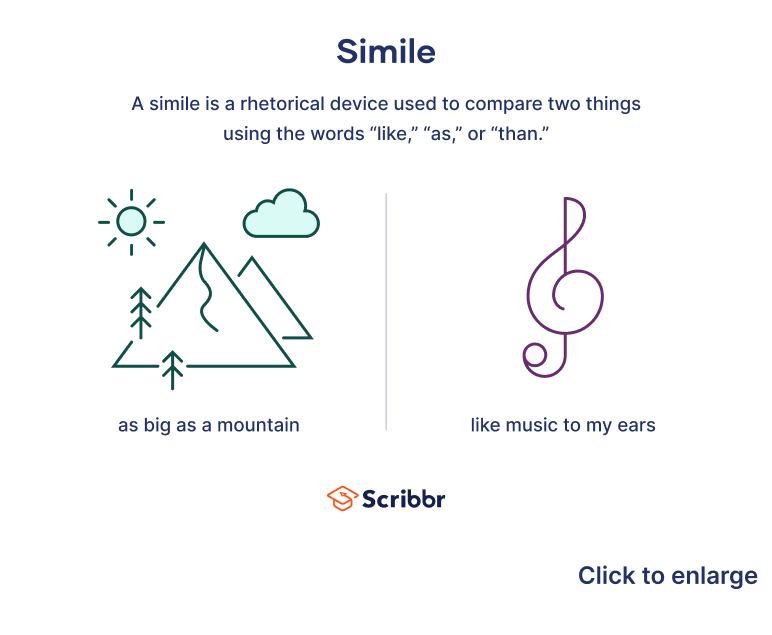What Is a Simile? | Meaning, Definition & Examples
A simile is a rhetorical device used to compare two things using the words “like”, “as”, or “than”.
Similes can be used to create vivid imagery or to draw surprising connections between two unrelated things. They’re commonly used in literature, advertising, and everyday speech and are closely related to metaphors and analogies.
Her phone buzzed like a beehive.
The dancer was as graceful as a swan.
Your laughter is like music to my ears.
What is a simile?
A simile is a comparison that uses the words “like”, “as”, or “than”.
Similes are used to emphasise or exaggerate a specific quality of one thing by comparing it to something else. Similes are effective because they “show” rather than “tell” (i.e., they use descriptive language to convey an idea instead of stating it as fact).
The child moved through the room like a tornado.
His tongue is sharper than a sword.
The protagonist’s heart beat like a drum.
Similes are commonly used in literature, speeches, advertising, and everyday speech. They can be used to create vivid images and to make surprising connections between two dissimilar things. However, they should be avoided in formal contexts like academic writing.
You look like your father.
You look like a million bucks.
I’m as fast as you.
I’m as fast as lightning.
Simile vs metaphor
Similes and metaphors are both used to make a comparison between two unlike things. However, they have different functions:
- A simile makes an explicit comparison between two things (e.g., “love is like a battlefield”).
- A metaphor makes an implicit comparison by saying that something is something else (e.g., “love is a battlefield”).
Unlike similes, metaphors don’t use the words “like”, “as”, or “than”. Instead, they usually contain a form of the verb “be” to equate two things (e.g., “you are an angel”). This is not literal but rather used to emphasise a specific, implied quality (in this case, “kindness”).
Mrs Kennedy’s eyes were diamonds.
The moon hung in the sky like a lantern.
The moon was a lantern.
Simile vs analogy
There are two main types of analogies:
- Identical relationship analogies indicate the logical relationship of things being compared (e.g., “A is to B as C is to D”).
- Shared abstraction analogies compare two unlike things that share a common quality to illustrate a point or make an argument.
Analogies of shared abstraction are closely related to similes, but they serve slightly different purposes. Both draw a comparison between two unlike things, but while similes are typically used to describe something, analogies of shared abstraction are used to explain something or to make an argument.
“A goal is like a compass – it gives you a sense of direction”.
“Life is like the theatre and we all play many roles”.
Common similes
Many common expressions are similes.
| Simile | Meaning |
| I ran like the wind. | Very fast |
| It fits like a glove. | Perfectly |
| The news hit me like a ton of bricks. | Very hard |
| He was drawn to her like a moth to a flame. | With intense interest |
| The children fight like cats and dogs. | Fiercely and often |
| The old woman is as fit as a fiddle. | In excellent physical health |
| My brother is as mad as a hatter. | Crazy or unpredictable |
| The waiter was as busy as a bee/beaver. | Industrious or hardworking |
| The package is as light as a feather. | Lightweight or delicate |
| The student is as sharp as a tack. | Intelligent or quick-witted |
Simile and metaphor worksheet
You can test your knowledge of the difference between similes and metaphors with the worksheet below. Choose whether each sentence contains a simile or a metaphor.
- You drink like a fish.
- Josephine is old, but she’s as fit as a fiddle.
- Life is a rollercoaster.
- Your smile is brighter than a thousand stars.
- You are an angel, but sometimes you can be as stubborn as a mule.
- You drink like a fish.
- This sentence contains a simile because it makes a direct comparison using the word “like”.
- Josephine is old, but she’s as fit as a fiddle.
- This sentence contains a simile because it makes a direct comparison using the word “as”.
- Life is a rollercoaster.
- This sentence contains a metaphor because it makes an implicit comparison by saying that something is something else.
- Your smile is brighter than a thousand stars.
- This sentence contains a simile because it makes a direct comparison using the word “than”.
- You are an angel, but sometimes you can be as stubborn as a mule.
- This sentence contains both a metaphor (“you are an angel”) and a simile (“as stubborn as a mule”).
Frequently asked questions
Cite this Scribbr article
If you want to cite this source, you can copy and paste the citation or click the ‘Cite this Scribbr article’ button to automatically add the citation to our free Reference Generator.
Ryan, E. (2023, October 26). What Is a Simile? | Meaning, Definition & Examples. Scribbr. Retrieved 3 December 2025, from https://www.scribbr.co.uk/rhetorical-devices/simile-meaning/




